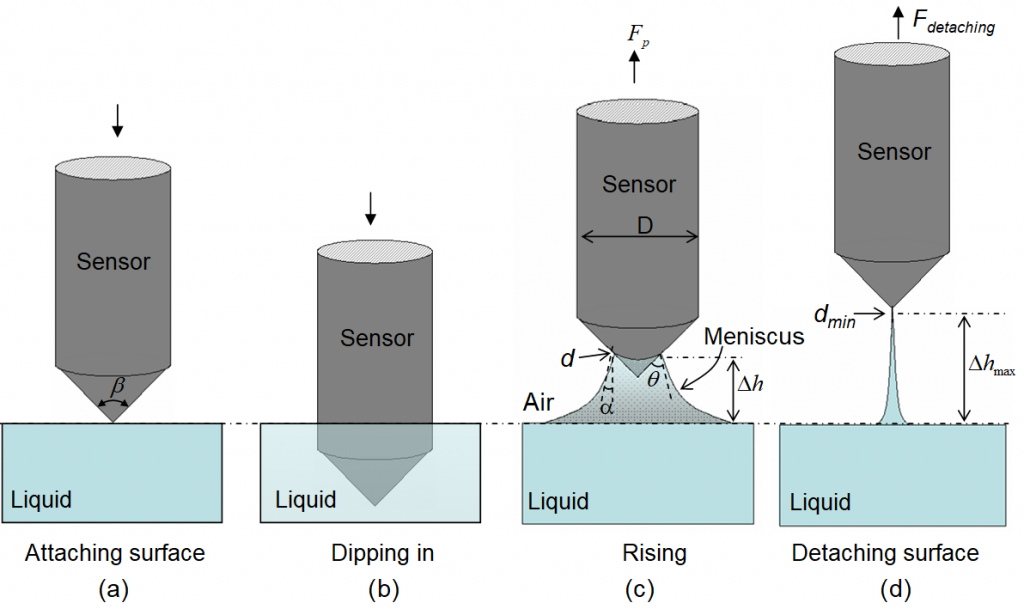Both surface and interfacial tensions can be measured with acceptable accuracy for chemical ranking or chemical selection using the multi-channel scanning water analyzer (MCSWA) directly or using a more compact form of the instrument, namely a multi-channel tensiometer. Fig. 1 is a photo of an 8-channel tensiometer.

Fig. 1. A photo of 8-channel tensiometer / scanning water analyzer.
The working principle is similar to and a variation of the Du Noüy-Padday rod method. It uses multiple stainless steel rods with a cone-shaped tip as capacitive sensors in conjunction with the MCSWA’s fully automated positioning system that can precisely achieve 0.06 % accuracy and 0.04 μm resolution. Fig. 2 is an illustration of the measuring process for a single sensor. Multiple sensors are arranged in parallel and automatically controlled for a multi-channel tensiometer, which is a bonus function of the multi-channel scanning water analyzer. For the sensor rising period, the excessive pulling force on the sensor, Fp , is approximately proportional to the height of the meniscus
![]()
where k is a sensor constant. The maximum height of the meniscus is measured to calculate surface or interfacial tension.
![]()
The coefficient, k/(πdmin), can be obtained via calibration using a reference liquid with known surface tension, such as water for aqueous systems, xylene for hydrocarbons.

Fig. 2. An illustration of the measuring process.
Features of the 8-channel tensiometer
- The very compact design makes it portable for field tests.
- Multi-functions for water profile analysis, surface and interfacial level identification and tension measurement.
- Automated multi-channel scanning measurement makes chemical selection efficient and environmentally friendly.
- The critical micelle concentration of a surface active agent can be measured in one test run.
- Meet the trend of energy digitization.
Specifications
- Name: 8-Channel scanning water analyzer & tensiometer
- Model: MCSWA-8-1000-1
- № of Channels: 8
- Water content resolution: 0.1% by volume
- Surface/interface level resolution: 0.1 mm
- Vertical stage velocity: ≤ 5 mm/s
- Vertical stage travel distance: 200 mm
- Scanning velocity: 0.1 – 0.2 mm/s for water analysis, 0.01-0.10 mm/s for surface/interfacial tension measurement
- Power supply for vertical stage motor: 24 V DC,
- Communication for vertical stage’s motor: USB to RS422
- Heating cell diameter: 63.5 mm for 200 ml glass bottles, 56.7 mm for 100 ml glass bottles
- Heating cell operating temperature: ≤ 95 ± 0.1℃, limited by water boiling point
- Power supply for heating cells: 85 – 240 V AC
- Front enclosure: manual
- Dimension: W350 mm × D590 mm × H600 mm
- Computer included
- Operating system: Win 10
- CPU: ≥ 1.5GHz
- Memory: ≥ 8GB
- Hard disk: ≥ 500G
- № of USB 2.0 and/or 3.0 port: 3
- HDMI: 1